- home
- BAKERECIPES
BakeRecipes
Bringing real baking into your home with deliciously simple recipes.
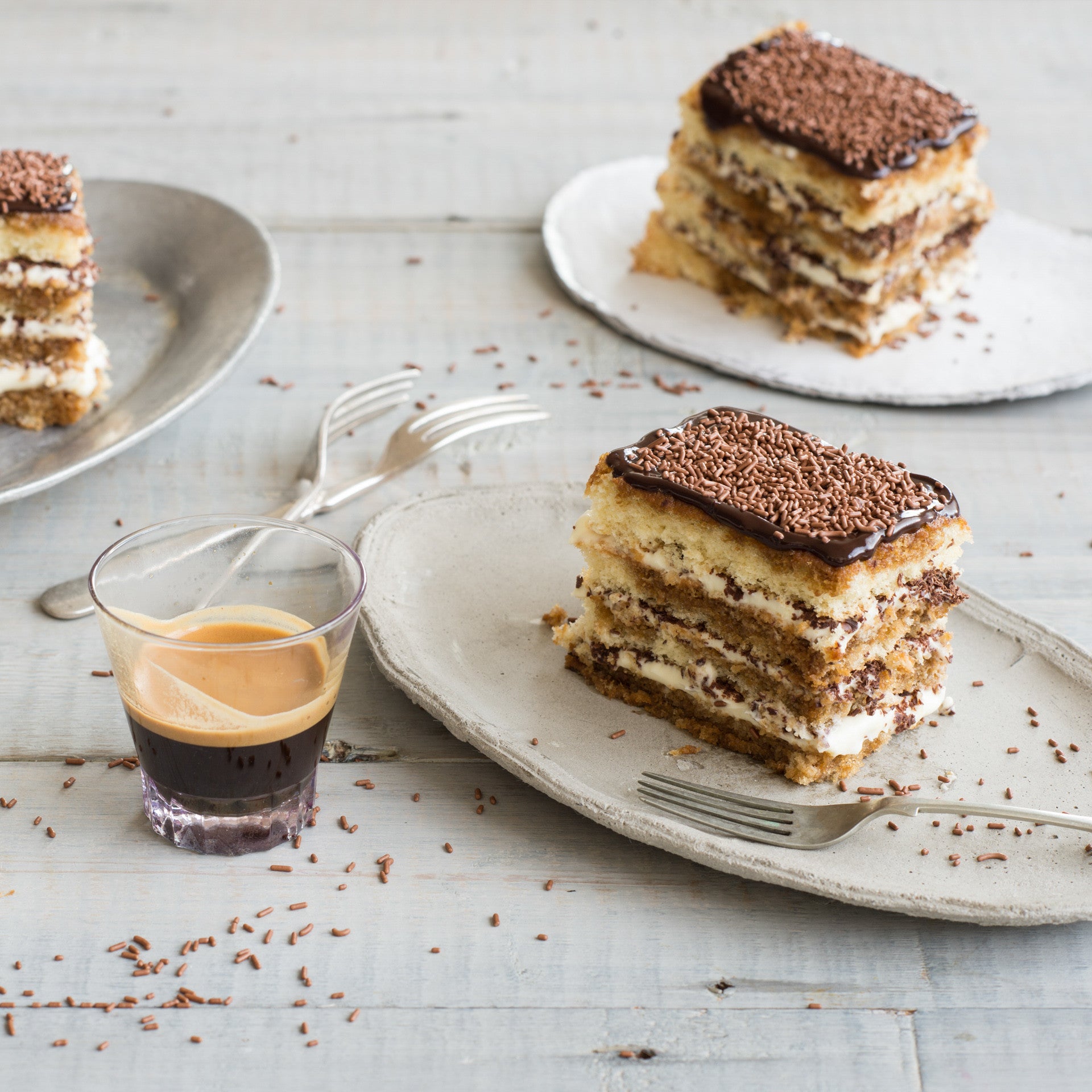
Prep 40min (+2hr 30min chilling and 20min cooling time)Bake 15minMakes 8 serves
This Italian classic is taken to a whole new level as elegant individual dessert cakes with a rich chocolate topping... Just serve with a fork!
Ingredients
185ml (¾ cup) strong freshly brewed coffee60ml (¼ cup) Marsala
75g good-quality dark chocolate (70% cocoa), grated
Chocolate dollar fives, to sprinkle (optional)
Sponge Layers
Melted butter, to grease4 eggs, at room temperature
165g (¾ cup) caster sugar
60ml (¼ cup) milk
20g butter
110g (¾ cup) self-raising flour, plus extra to dust
30g (¼ cup) cornflour
Mascarpone mixture
150ml thickened cream90g (⅔ cup) icing sugar, sifted
125g mascarpone
Chocolate ganache
250g good-quality dark chocolate (54% cocoa), chopped80ml (⅓ cup) pouring cream
Method
- To make the Sponge Layers, place the oven rack in the lower third of the oven and then preheat it to 180°C (160°C fan-forced). Brush two 30cm x 20cm shallow cake tin with a little melted butter to lightly grease and hen line the base and sides with one piece of baking paper, cutting into the corners to fit.
- Use an electric mixer with a whisk attachment on high speed to whisk the eggs and sugar in a large bowl until until the mixture is very thick and pale (this will take about 5 minutes). Lift the whisk out of the mixture and draw a figure eight, if the trail stays on the surface long enough for you to finish drawing then the mixture is ready. If not, continue to whisk for a further minutes and then test again.
- Heat the milk and butter in a small saucepan over medium heat just until the butter melts. Remove from the heat. Sift the flour and cornflour together over the egg mixture. Immediately pour the warm milk mixture down the side of the bowl and whisk again with the electric mixer briefly, until the flour mixture is just incorporated (be careful not to over mix).
- Divide the mixture evenly between the prepared tins, and use a spatula or the back of a spoon to spread evenly. Gently tap the tins on the bench top three times to settle the mixture. Bake in preheated oven for 12-14 minutes or until the cake is a pale golden colour, spring back when lightly touched in the centre and start pulling away from the sides of the tin. Remove from the oven and stand for 2 minutes before turning onto a wire rack to cool completely (this will take about 20 minutes).
- Line the base and sides of a 16cm x 26cm cake tin with two strips of non-stick baking paper allowing the paper to overhand the sides by about 10cm.
- To make the mascarpone mixture, use an electric mixer with a whisk attachment to whisk the cream and icing sugar on medium speed until soft peaks form. Add the mascarpone and whisk until firm peaks just form.
- Cut each of the sponge in half. Combine the coffee and Marsala. Place one sponge layer on the base of the prepared tin and sprinkle with a quarter of the coffee mixture. Spread with a third of the Mascarpone mixture (about ½ cup) and then sprinkle with a third of the grated chocolate. Continue to layer with the remaining sponge, coffee mixture, grated chocolate and mascarpone mixture, finishing with a sponge layer sprinkled with the remaining coffee and Marsala mixture. Cover with plastic wrap and place in the fridge for at least 2 hours or until firm enough to cut.
- Use the overhanging baking paper to remove the tiramisu from the tin and transfer to a cutting board. Use a sharp knife trim the edges and then cut into 8 portions about 4.5cm x 7cm each and place on a wire rack over a tray. Return to the fridge while making the Chocolate ganache
- To make the Chocolate ganache, combine the chocolate and cream in a heatproof bowl and place over a saucepan of barely simmering water (make sure the base of the bowl doesn’t touch the water). Stir occasionally until just melted and combined.
- Remove the cakes from the fridge and place on a wire rack. Pour a little of the Chocolate ganache over each cake, spreading it to cover the top. Sprinkle with the chocolate Dollar Fives if using and return to the fridge for 30 minutes or until the ganache is set before serving.
Baker's Tips
- These Tiramisu cakes will keep in an airtight container in the fridge for up to 3 days.
This recipe is from Anneka's SBS Food online column, Bakeproof: Little Cakes. CLICK HERE for more Bakeproof recipes.
Photography by Alan Benson.
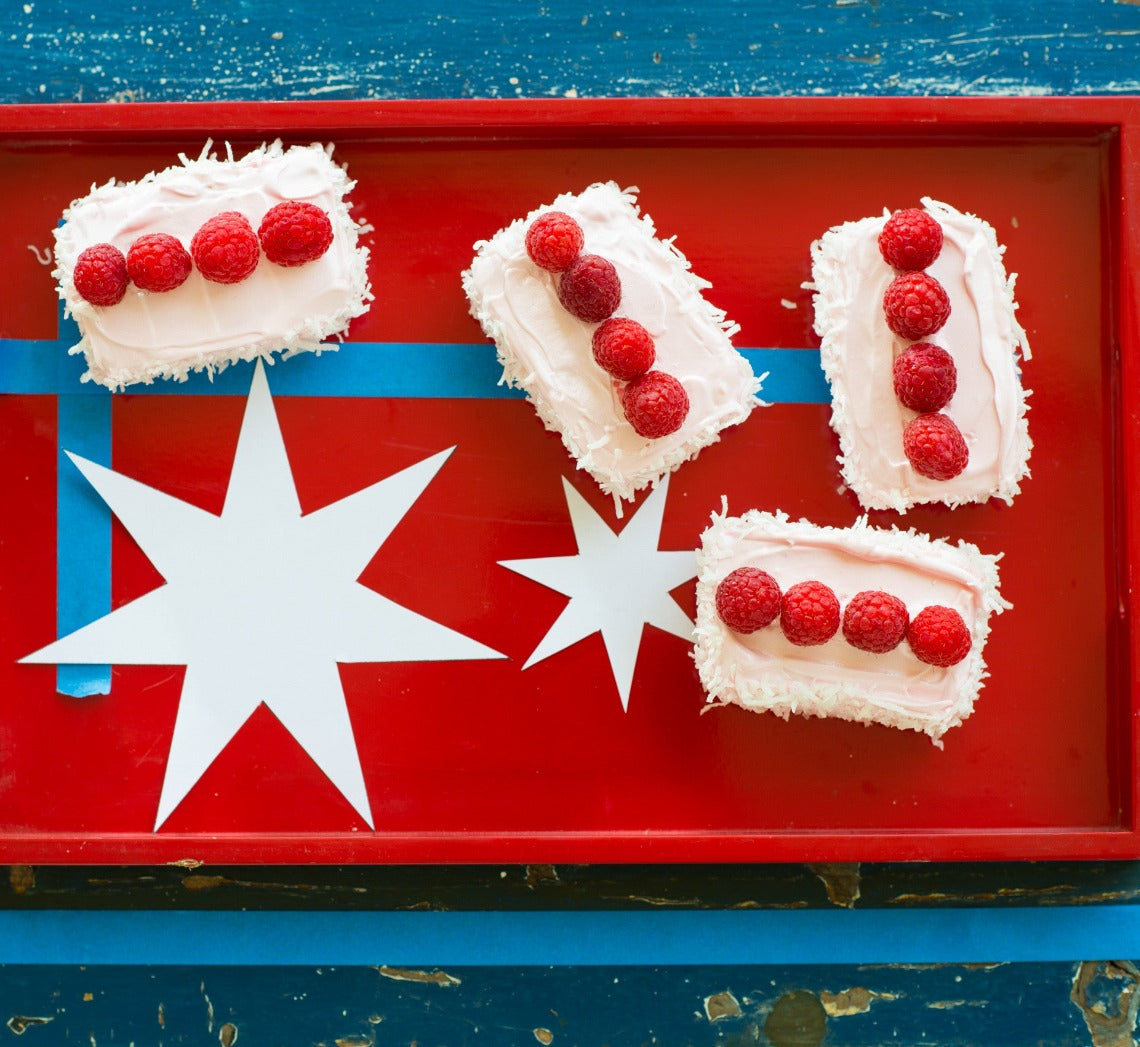
Prep 50min (+30min cooling and 30min standing time)Bake 25minMakes about 12
I debated about what to call these — a combination of the much-loved Arnott’s iced VoVo biscuits and the iconic lamington. Such a visual treat. I hope you love these fun little cakes as much as I do.
Ingredients
130g (2 cups) shredded coconut
48 fresh raspberries, halved lengthways, to decorate
Cakes
melted butter, to grease
105g (¾ cups) self-raising flour
75g (½ cup) plain flour
165g (¾ cup) caster sugar
125g butter, at room temperature
80ml (⅓ cup) milk
2 eggs, at room temperature
1 teaspoon natural vanilla extract or essence
1½ tablespoons raspberry jam
Raspberry frosting
2 egg whites
75g (⅓ cup) caster sugar
2 tablespoon raspberry jam, warmed and sieved
rose pink food colouring
Method
- Preheat the oven to 180°C (160°C fan-forced). Brush a 12 x 80ml (⅓ cup) rectangular friand or mini-loaf pan with melted butter to grease.
- Place the flour, sugar, butter, milk, eggs and vanilla in a large mixing bowl. Use an electric mixer to beat on low speed until combined. Increase the speed to medium and beat for 3 minutes or until the mixture is well combined and very pale in colour. Divide half the mixture among the friand pans and spoon the surface of each with the back of a teaspoon. Spoon ½ teaspoon of jam into the centre of each and then spoon the remaining cake batter over the top to cover, dividing evenly, and smoothing the surfaces carefully with the back of the spoon.
- Bake for 20-25 minutes or until the cakes are golden and cooked when tested with a skewer. Cool for 5 minutes in the pan, then transfer to a rack to cool completely (this will take about 30 minutes).
- To make the raspberry frosting, choose a medium heatproof mixing bowl that sits snugly on top of a medium saucepan. Quarter-fill the saucepan with water and bring to the boil. Reduce the heat to lowest possible setting. Put the egg whites and sugar in the heatproof bowl and place over the simmering water. Use a spatula to stir until the sugar dissolves. (You can tell if the mixture is ready by rubbing a little between your fingers — if it still feels grainy then continue to stir for another minute or until it no longer feels grainy.) Transfer the mixture to the bowl of an electric mixer and use a whisk attachment to whisk on high speed for 3-5 minutes or until very thick and glossy. Whisk in the jam until evenly combined. Add 2-3 drops, or enough to reach desired colour, of the food colouring to the meringue mixture and whisk until evenly combined.
- When the cakes are cool, spread the coconut on a tray. Spread the raspberry frosting over the top and sides of a cake and then dip the sides in the coconut to coat. Place on a serving plate and place 4 raspberry halves down the centre on top to decorate. Repeat with the remaining cakes, frosting, coconut and fresh raspberries. Set aside for 30 minutes for the frosting to firm slightly before serving.
Baker's Tips
- These cakes, without the fresh raspberries, will keep in an airtight container at room temperature for up to 2 days.
This recipe is from Anneka's SBS Food online column, Bakeproof: Aussie Day Favourites.
CLICK HERE for more Bakeproof recipes.
Photography by Alan Benson.
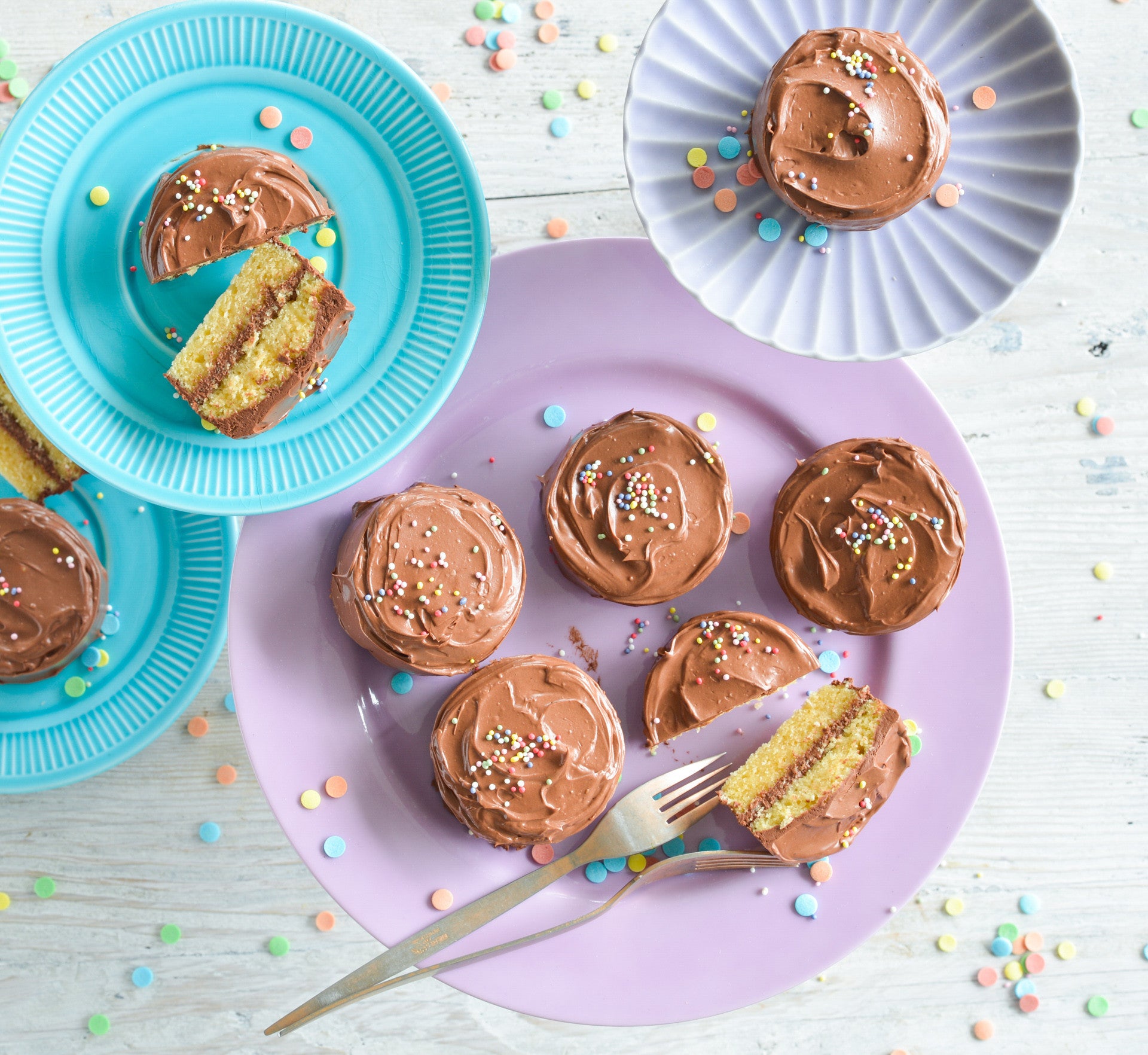
Prep 40min (+30min cooling time)
Bake 25minMakes about 10
Everyone needs a good classic yellow cake in their repertoire and this one, made as cute individual cakes with a rich, velvety fudge frosting, is the one to add. Have some fun with the decorations – there are so many edible sprinkles to choose from you may want to give each individual cake its own unique identity.
Ingredients
- 20g butter, melted and combined with 1 teaspoon plain flour, to grease
- 125g salted butter, softened
- 165g (¾ cup) caster sugar
- 2 teaspoon natural vanilla essence or extract
- 1 egg, at room temperature
- 2 egg yolks, at room temperature
- 225g (1½ cups) plain flour
- 2½ teaspoon baking powder
- 125ml (½ cup) buttermilk or milk
- Sprinkles of your choice, to decorate
Chocolate fudge frosting
- 1 tablespoon cocoa powder, sifted
- 1 tablespoon hot water
- 185g salted butter, softened
- 60g (½ cup) icing sugar mixture, sifted
- 1 teaspoon natural vanilla essence or extract
- 250g good-quality dark chocolate (54% cocoa), melted and cooled
Method
- Preheat the oven to 190°C (170°C fan-forced). Brush a 12-hole 80ml (⅓ cup) muffin pan with the melted butter mixture to grease.
- Use an electric mixer with a paddle attachment to beat the butter, sugar and vanilla until very pale and creamy. Add the egg and beat until well combined. Beat in the egg yolks, scraping down the sides of the bowl when necessary, until well combined and the mixture is pale and creamy.
- Sift together the flour and baking powder. With the motor running on lowest possible speed, add half the flour mixture and beat until just combined. Add the buttermilk or milk and beat on low until just combined. Add the remaining flour and beat until just combined.
- Divide the mixture evenly between the muffin holes and use the back of a spoon to smooth the tops. Bake for 25 minutes or until golden and cooked when tested with a skewer inserted in the centre. Stand in the tin for 5 minutes before transferring to a wire rack to cool.
- Meanwhile, to make the Chocolate Fudge Frosting, combine the cocoa powder and water in a small dish and stir until smooth and a paste forms. Set aside until cooled to room temperature. Use an electric mixer to beat the butter and icing sugar until very pale and creamy, scraping down the sides of the bowl when necessary. Gradually beat in the cooled chocolate and cocoa mixture until smooth and well combined.
- Cut each of the cooled cakes in half horizontally. Use a palette knife or the back of a teaspoon to spread a little of the chocolate fudge frosting over the bottom half of a cake and sandwich with the top half. Spread the top and sides of the cake generously with some of the remaining frosting, swirling on top and making an indent in the centre. Decorate with sprinkles. Repeat with the remaining cakes, frosting and sprinkles.
Baker's Tips
- These cakes will keep in an airtight container at room temperature for up to 2 days.
This recipe is from Anneka's SBS Food online column, Bakeproof: Little Cakes. CLICK HERE for more Bakeproof recipes.
Photography by Alan Benson.
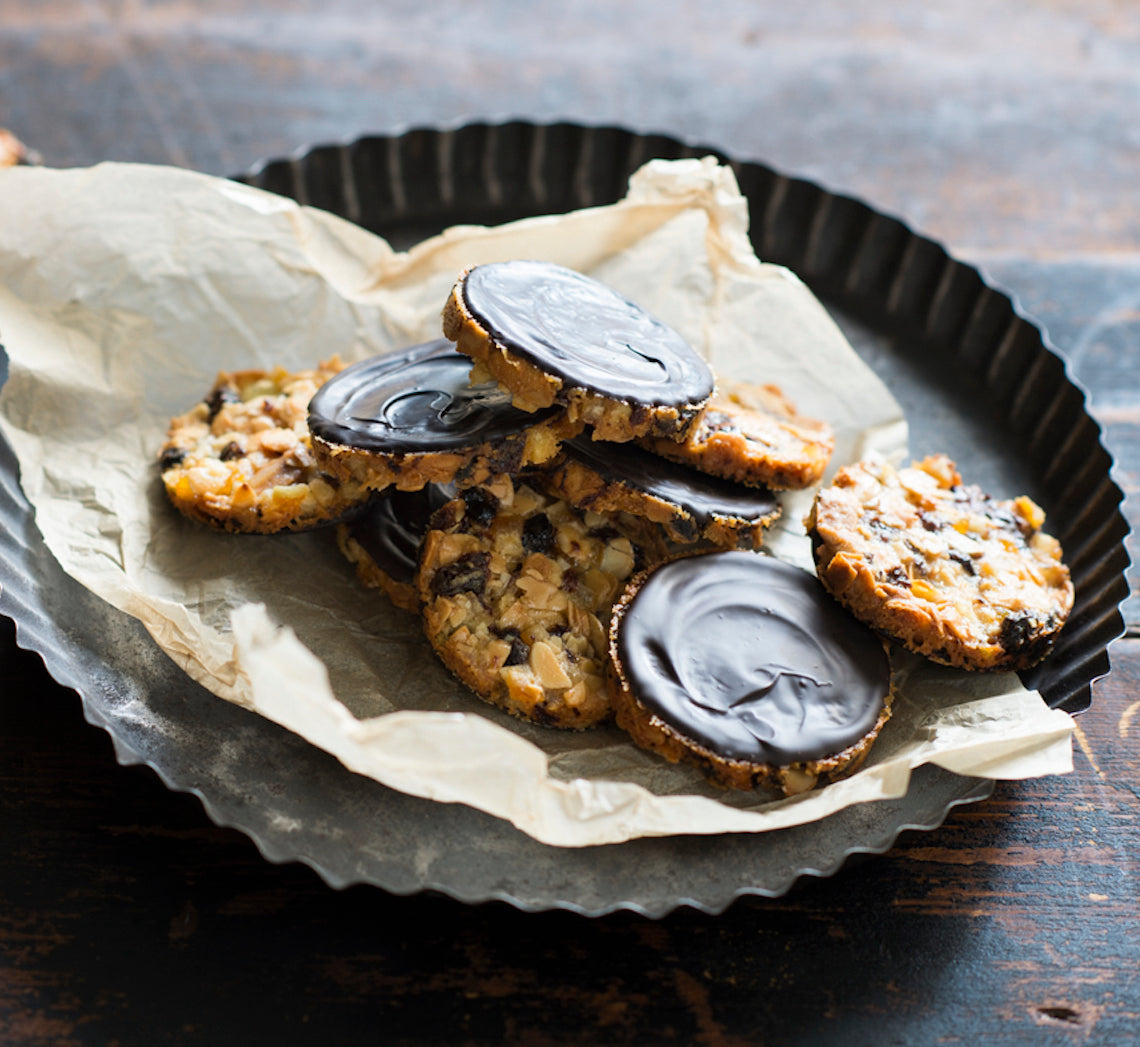
Prep 20minBake 25min(per batch)Makes about 24
Often attributed to the Italians, it is believed that Florentines were actually created in the royal French kitchens in the late 1600s in honour of their Tuscan in-laws, hence their name. Admittedly a little confusing for us, but incredibly flattering for the in-laws!
Ingredients
Melted butter, to grease
200g flaked almonds
150g sour dried cherries, finely chopped
150g candied orange rind, finely chopped
75g (½ cup) plain flour
75g butter, cubed
75g (⅓ cup) caster sugar
115g (80ml/⅓ cup) honey
200g good-quality dark chocolate (70% cocoa), melted and cooled (see Baker's Tips)
Method
- Preheat oven to 160°C (140°C fan-forced).
- Line an oven tray with non-stick baking paper. Brush the inside of six 7.5cm metal egg rings (see Baker's Tips) with a little melted butter to grease and place on the lined oven tray.
- Combine the flaked almonds, dried cherries, candied orange rind and flour in a large bowl and stir to combine evenly. Combine the butter, sugar and honey in a small saucepan and stir over medium heat until the butter just melts and the mixture is well combined. Add to the almond mixture and stir gently with a large metal spoon or spatula until evenly combined.
- Spoon 1½ tablespoons of the mixture into an egg ring to fill half way and use the back of a metal spoon to spread, leaving it a little uneven if you want. Repeat with more mixture and the remaining five egg rings.
- Bake in preheated oven for 25 minutes or until golden and cooked through. Remove from the oven and cool on the trays for 5 minutes before removing the egg rings. Grease the egg rings again with a little more melted butter and repeat with the remaining mixture in three more batches.
- Use a palette knife or the back of a teaspoon to spread a generous amount of melted chocolate over the underside of a florentine to cover. Place on a wire rack, chocolate side up and set aside for 1 hour or until the chocolate sets. Repeat with the remaining cooled florentines.
Baker's Tips
- The longer the chocolate cools the thicker it will become and the more defined the 'swirls' of chocolate will be.
- Non-stick egg rings are perfect to use to make these florentines, but they will still need to be greased.
- These florentines will keep in an airtight container or jar in a cool dark place for up to 2 weeks.
This recipe is from Anneka's SBS Food online column, Bakeproof: Gifts from the Kitchen. CLICK HERE for more Bakeproof recipes.
Photography by Alan Benson.
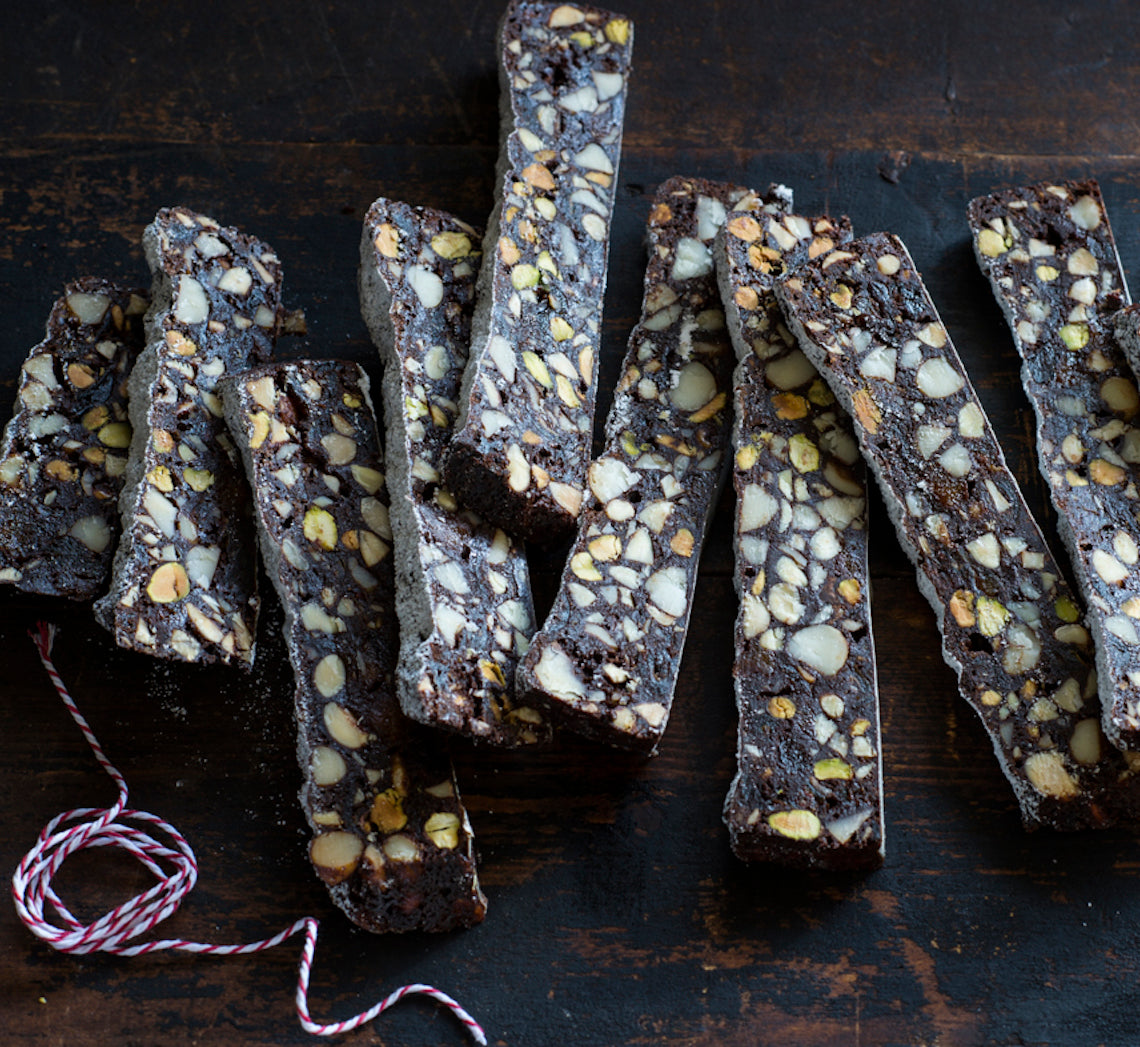
Prep 30min (+2hr cooling time)Bake 40-45minMakes about 20-24 pieces
Hailing from Siena in the Tuscan region of Italy, panforte (‘strong bread’ when translated to English) is a delectable combination of dried fruits, nuts, spices, honey and, if you are lucky, chocolate. It is believed to date back to the 13th Century and was originally a form of tax paid to a local monastery. Like many traditional recipes, there are many variations with each often being a well-guarded family recipe – however I will share this one with you!
Ingredients
- Melted butter, to grease
- 2 sheets confectioner's rice paper (see Baker's Tips)
- 75g (½ cup/2¾oz) plain flour
- 40g (⅓ cup/1½oz) cocoa powder
- 1 teaspoon ground cinnamon
- ½ teaspoon freshly ground black pepper
- 70g (½ cup/2½oz) dried pitted dates, coarsely chopped
- 80g (½ cup/2¾oz) prunes, coarsely chopped
- 80g (2¾oz) glace apricots, chopped
- 155g (1 cup/5½oz) unsalted roasted macadamias, coarsely chopped
- 160g (1 cup/5¾oz) blanched almonds, coarsely chopped
- 70g (½ cup/2½oz) unsalted pistachio kernels
- 100g (3½oz) good-quality dark chocolate, chopped
- 1½ tablespoon finely grated orange rind
- 175g (½ cup/6¼oz) honey
- 110g (½ cup/4oz) caster sugar
- 2 tablespoon water
- 1 teaspoon natural vanilla essence or extract
- Icing sugar or extra cocoa powder, to dust
Method
- Preheat oven to 170°C/340°F (150°C/300°F fan-forced).
- Brush a shallow round 20cm/8in (base measurement) tin with melted butter to grease and then line the base with a circle of rice paper, cutting the sheets to fit. Line the sides with a strip of non-stick baking paper.
- Sift the flour, cocoa and spices into a large bowl, then stir in the fruit, nuts, chocolate and orange rind. Set the bowl on a folded tea towel (see Baker's Tips).
- Put the honey, sugar and water in a small saucepan. Stir over low heat, without boiling, until the sugar dissolves. Bring to the boil and simmer, uncovered and without stirring, for 5 minutes. Immediately pour the hot syrup and vanilla over the fruit and nut mixture and, working quickly, stir with a wooden spoon until well combined. Press mixture firmly and evenly into prepared tin.
- Bake for 40-45 minutes or until firm to touch in the centre. Cool in the pan sitting on a wire rack (this will take about 2 hours).
- Remove from pan and dust liberally with icing sugar or cocoa. Serve in thin slices or wedges.
Baker's Tips
- Confectioner's rice paper sheets are available from Asian grocers, delicatessens and specialty food stores. Don't confuse it with Asian rice paper, used to make rice paper rolls.
- Before adding the hot syrup to the fruit and nut mixture, place a tea towel under the bowl to stop it from slipping when mixing.
- To make individual panforte, grease eight 8cm (base diameter) loose-bottomed tart tins with oil spray or melted butter and line the bases with a circle of edible rice paper. Divide the mixture among the tins and press down firmly. Bake for 25-30 minutes.
- This panforte will keep wrapped well in plastic wrap at room temperature in a cool spot for up to 1 month.
This recipe is from Anneka's SBS Food online column, Bakeproof: Gifts from the Kitchen.
CLICK HERE for more Bakeproof recipes.
Photography by Alan Benson.
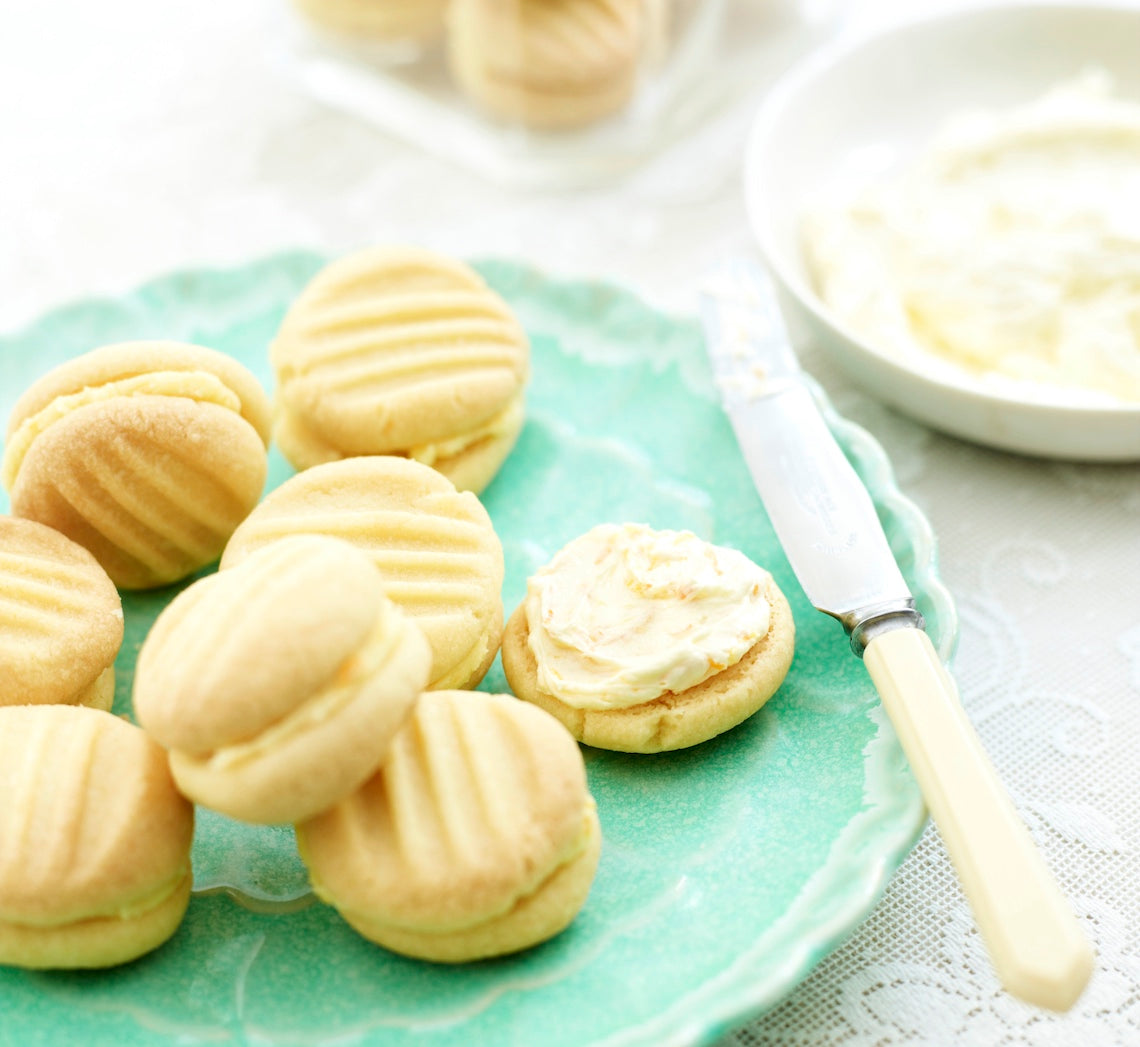
Prep 40minBake 16-18minMakes about 18
These melt-in-the-mouth buttery biscuits, sandwiched with a creamy, sweet buttercream, are an all-time favourite. This version has the addition of orange zest in the filling, which adds a subtle citrus tang. They're the perfect accompaniment to a cuppa.
Ingredients
250g butter, cubed, softened
110g (⅔ cup) icing sugar
1½ teaspoons natural vanilla essence or extract
250g (1⅔ cups) plain flour
60g (½ cup) cornflour
Orange buttercream filling
60g butter, softened
1 orange, zest finely grated
125g (1 cup) icing sugar, sifted
Method
- Preheat the oven to 160°C. Line 2 large baking trays with baking paper.
- Use an electric mixer on medium to beat the butter, icing sugar and vanilla until pale and creamy, scraping down the side of the bowl when necessary.
- Sift the flour and cornflour together over the butter mixture. Mix on low speed (or use your hands to mix) until just combined and a soft dough forms.
- Use lightly floured hands to roll heaped teaspoonfuls of the mixture into balls and place on the lined trays, about 5cm apart (you should have about 36 balls). Dip a fork in flour and use it to flatten the balls to about 1cm thick and 4cm in diameter.
- Bake in preheated oven for 16-18 minutes, swapping the trays after 8 minutes, or until the biscuits are a pale golden colour. Remove from the oven and cool on the trays.
- While the biscuits are cooling, make the orange buttercream filling. Put the butter and orange zest in a small mixing bowl and use an electric mixer to beat on medium speed until pale and creamy. Add the icing sugar and beat on low speed, scraping down the side of the bowl when necessary, until well combined and smooth.
- To join the biscuits, spread a little buttercream on the base of a cooled biscuit and sandwich with another biscuit. Repeat with the remaining biscuits and filling.
Baker's Tips
- These biscuits will keep in an airtight jar or container in a cool place (not the fridge) for up to 4 days.
Photography by Julie Renouf.
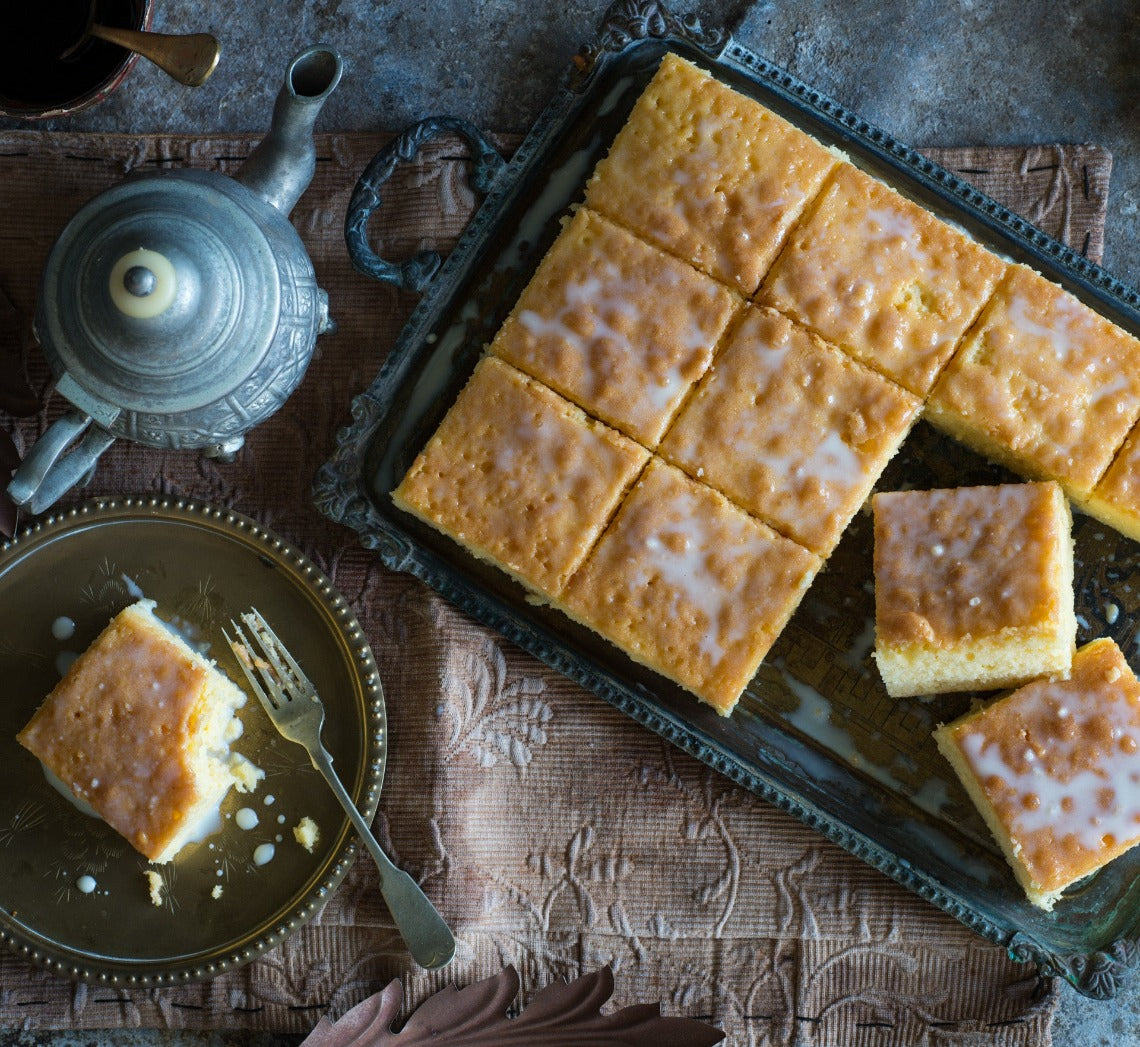
Prep 30min (+3hr chilling and 2hr cooling time)Bake 35minMakes 12 serves
Immensely well-loved in Latin America, a recipe for this wonderfully milky cake appeared on the label of Nestle’s sweetened condensed milk cans in the 1940s, possible explaining why its popularity has spread so widely in this part of the world.
Ingredients
Sponge Cake
5 eggs, at room temperature
220g (1 cup/7¾oz) caster sugar
125g (4½oz) butter, melted
150g (1 cup/5¼oz) plain flour
75g (½ cup/2¾oz) self-raising flour
1 teaspoon natural vanilla essence or extract
Milk Syrup
395g tin sweetened condensed milk
150ml evaporated milk
250ml (1 cup) full-cream milk
Method
- Preheat the oven to 180°C/350°F (160°C/315°F fan-forced). Grease a 20cm x 30cm (8in x 12in), base measurement, shallow cake tin or lamington pan and line the base and two longs sides with one piece of non-stick baking paper.
- Use an electric mixer with a whisk attachment to whisk the eggs on high speed until combined. Gradually add the sugar, about 55g (¼ cup/2oz) at a time, whisking well after each addition. Once all the sugar has been added, whisk on high for a further 4 minutes or until the mixture is very thick and a ribbon trail forms when the whisk is lifted. Reduce the mixer speed to low and gradually add the melted butter, whisking until just incorporated. Sift together the plain and self-raising flours. Add to the egg mixture in three separate batches, whisking on low speed between each addition until just combined and scraping the bottom of the bowl when necessary to make sure all the flour is incorporated.
- Pour batter into the prepared tin and gently tap it on the bench three times to remove any excess air bubbles. Bake in preheated oven for 30-35 minutes or until the cake is firm when touched in the centre and a skewer inserted in the centre comes out clean.
- Just before the sponge is ready, make the Milk Syrup by combining the sweetened condensed milk, evaporated milk and milk in and bowl and stirring with a balloon whisk until well combined. Transfer to a jug.
- Remove the sponge from the oven and stand in the tin for 3 minutes before inverting onto a tray with a lip. Use a skewer to prick holes all over the surface of the cake and all the way through. Pour the milk mixture evenly and slowly over the warm cake, allowing it to soak it up. Stand at room temperature until cool (this will take about 2 hours) and then refrigerate, uncovered, for 3 hours or overnight. Cut into pieces to serve (see Baker's Tips).
Baker's Tips
- For an extra rich cake you can top it with 375 ml (1½ cups) thickened cream that has been whisked to soft peaks with 2 tablespoons of sifted icing sugar and 1 teaspoon of natural vanilla essence or extract before serving.
- This cake will keep covered in the fridge for up to 3 days. Serve at room temperature.
This recipe is from Anneka's SBS Food online column, Bakeproof: Latin American Cakes.
CLICK HERE for more Bakeproof recipes.
Photography by Alan Benson.
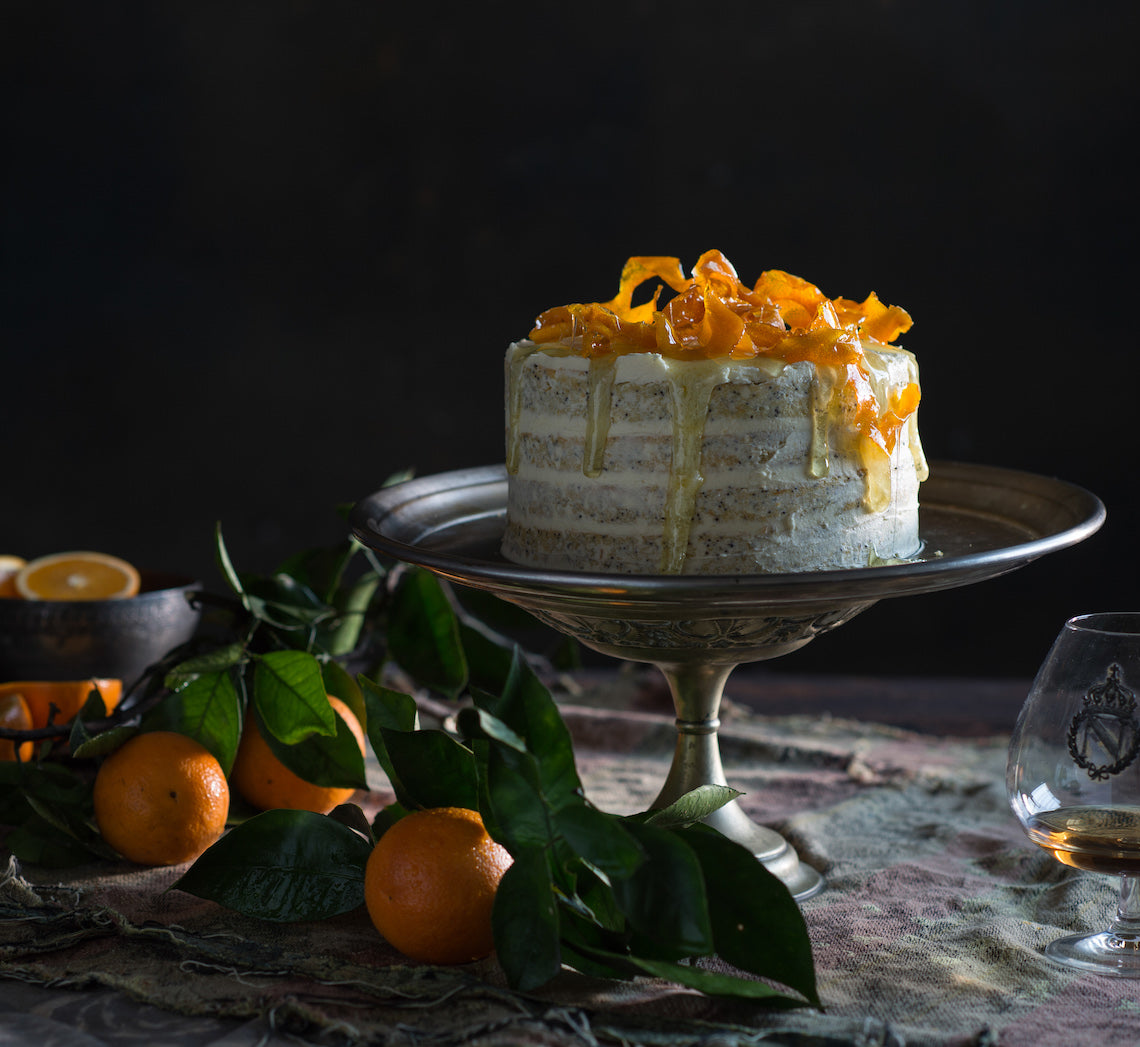
Prep 45min (+30min cooling time per batch)Bake 45minMakes 12-14 serves
This pretty cake, with its heavenly orange blossom-scented frosting, is currently one of my favourite 'special occasion' cakes – particularly for birthday celebrations. The cake layers are baked in two batches but if you are lucky enough to have four cake pans that can fit in your oven all at once, feel free to make the mixture in one lot and bake them all together.
Ingredients
Melted butter, to grease
Orange poppy seed cake layers
3 oranges
3 tablespoons poppy seeds
125g (½ cup) sour cream
250g butter, cubed, at room temperature
300g (1⅓ cups) caster sugar
4 eggs
350g (2⅓ cups) plain flour
3 teaspoons baking powder
Candied orange rind
3 oranges
220g (1 cup) caster sugar
250ml (1 cup) water
Orange blossom water buttercream
250g butter, at room temperature
375g (3 cups) icing sugar, sifted
3-4 teaspoons orange blossom water (or to taste)
Method
- To make the cake layers, preheat the oven to 180°C. Grease two shallow 20cm (base measurement) round cake tins with melted butter and line the bases with rounds of non-stick baking paper.
- Finely grate the rind from the oranges and set aside. Juice the fruit and measure 125ml (½ cup), reserving the rest for another use. Divide the juice evenly between two medium bowls. Add half the poppy seeds and half the sour cream to each. Set aside.
- Use an electric mixer to beat 125g of the butter, 150g of the sugar and half the orange rind until pale and creamy. Add 2 of the eggs, one at a time and beating well after each addition. Sift together 175g of the flour and 1½ teaspoon of the baking powder. Fold half the flour mixture through the butter mixture until just combined. Fold through one quantity of the poppy seed mixture and then the remaining flour mixture until just combined.
- Divide the cake mixture evenly between the prepared cake tins and use the back of a metal spoon to smooth the surfaces. Bake in the preheated oven for 20-25 minutes or until a skewer inserted into the centre of the cakes come out clean. Stand in the tins for 5 minutes before turning onto wire racks, topside down, to cool (this will take about 30 minutes).
- Repeat with the remaining poppy seed mixture and ingredients to make two more cake layers.
- Meanwhile, to make the candied orange rind, use a vegetable peeler to remove the rind from the oranges in wide strips. Use a small sharp knife to remove any white pith from the rind. Combine the sugar and water in a small saucepan and stir over low heat until the sugar dissolves. Add the orange rind strips and bring to a simmer. Simmer, without stirring, for 10-15 minutes or until the rind is translucent. Use a fork to transfer the rind from the syrup to a wire rack. Set aside. Reserve the syrup.
- To make the orange blossom water buttercream, use an electric mixer to beat the butter, icing sugar and orange blossom water in a medium bowl until very pale and creamy. Cover and set aside at room temperature.
- To assemble the cake, place a cake layer, topside down, on a serving plate or cake stand. Spread with a little of the buttercream and then top with another layer of cake. Continue to layer with some of the remaining buttercream and cake layers, finishing with a cake layer. Spread a thin layer of buttercream around the outside of the cake so that the cake layers show through. Spread the remaining buttercream on top, swirling as desired. Decorate with the candied orange rind and drizzle with some of the remaining syrup just before serving.
Baker's Tips
- This cake will keep in an airtight container at room temperature for up to 3 days.
This recipe is from Anneka's SBS Food online column, Bakeproof: Citrus.
CLICK HERE for more Bakeproof recipes.
Photography by Alan Benson.
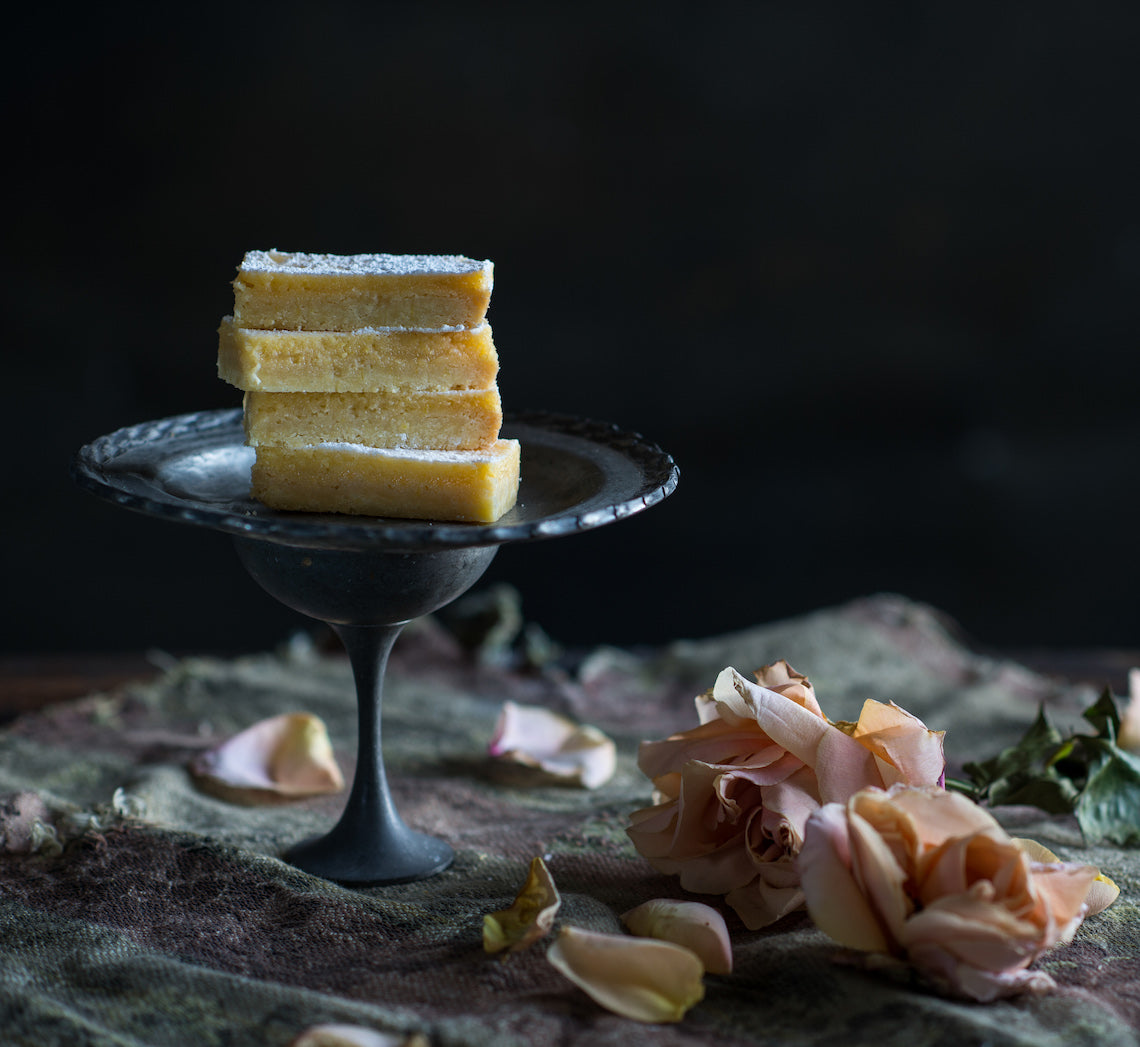
Prep 20min (+1hr cooling time)Bake 1hrMakes about 16
Lemon bars are one of those ‘clever’ slices that combines a simple shortbread-like base and an intensely-tart/sweet lemon topping to create a memorable mouth puckering moment – old-fashioned yet slightly sophisticated, all at the same time.
Ingredients
Base
150g (1 cup) plain flour
50g (¼ cup) caster sugar
150g chilled butter, diced
1 teaspoon natural vanilla essence or extract
Topping
3 eggs, at room temperature
165g (¾ cup) caster sugar
1 tablespoon finely grated lemon rind
125ml (½ cup) strained freshly squeezed lemon juice
2 tablespoons flour
Method
- Preheat oven to 180°C. Grease a 16cm x 26cm (base measurement) slice tin with butter and line the base and sides with one piece of non-stick baking paper, cutting into the corners to fit.
- To make the base, combine the flour, sugar, butter and vanilla in the bowl of a food processor and process until mixture is evenly combined and just starts to come together. Tip mixture into the prepared tin and use your hands to press it evenly over the base. Bake in preheated oven for 20 minutes or until it is golden around the edges.
- To make the topping, use a balloon whisk to whisk together the eggs, sugar and lemon rind and juice until well combined. Add the flour and stir until just combined. Pour the topping over the warm base and return to the oven for 15-20 minutes or until the topping is just set in the center.
- Cool the slice in the tin on a wire rack (this will take about 1 hour). Use the baking paper to lift the slice from the tin. Cut into bars and dust with icing sugar to serve.
Baker's Tips
- These bars will keep in an airtight container in a cool spot (but not in the fridge) for up to 3 days.
This recipe is from Anneka's SBS Food online column, Bakeproof: Citrus.
CLICK HERE for more Bakeproof recipes.
Photography by Alan Benson.
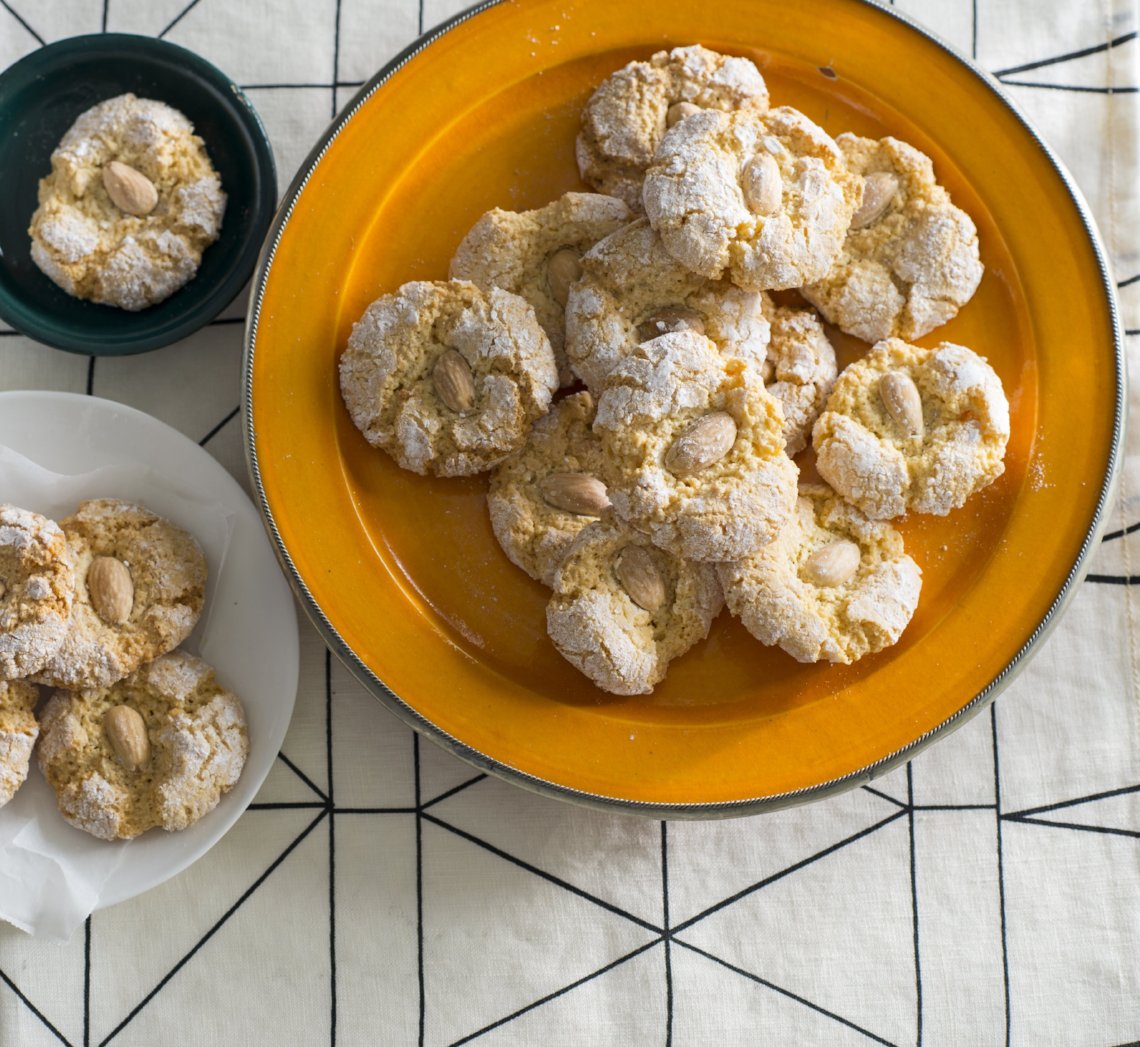
Prep 20minBake 30minMakes about 30
These "very Moroccan" cookies are dead-easy to make, but still special with the addition of orange flower water. They have a crisp macaroon-like character that softens and becomes chewy the longer they're kept.
Ingredients
240g (1½ cups) blanched almonds, plus 30 extra to decorate (optional)125g (1 cup) pure icing sugar, plus 2 tablespoons extra to coat
1 teaspoon baking powder
3 egg yolks
2 teaspoons orange flower water
Method
- Preheat oven to 180°C (160°C fan-forced). Line two large oven trays with non-stick baking paper.
- Spread the almonds on one of the baking trays and toast in preheated oven, shaking the tray occasionally, for 8-10 minutes or until lightly golden and aromatic. Set aside for 5 minutes to cool slightly.
- Use a food processor to process the almonds until finely ground. Transfer to a medium mixing bowl.
- Sift together the icing sugar and baking powder over the almond meal. Add the egg yolks and orange flower water and use an electric mixer to beat until well combined and a soft dough forms. Roll heaped teaspoonfuls of the mixture into balls. Roll in the extra icing sugar to coat lightly and then place on the lined oven trays about 5cm apart. Flatten the balls until about 1cm thick and then press a whole extra almond into the center of each, if desired.
- Bake in preheated oven for 20 minutes, swapping the trays around halfway through baking, or until lightly golden around the edges and cracked on top. Remove from the oven and cool on the trays.
Baker's Tips
- These ghoribas will keep in an airtight container at room temperature for up to 2 weeks.
- For a slightly soft centre bake these biscuits for only 16 minutes.
This recipe is from Anneka's SBS Food online column, Bakeproof: Moroccan Spice.
CLICK HERE for more Bakeproof recipes.
Photography by Alan Benson.
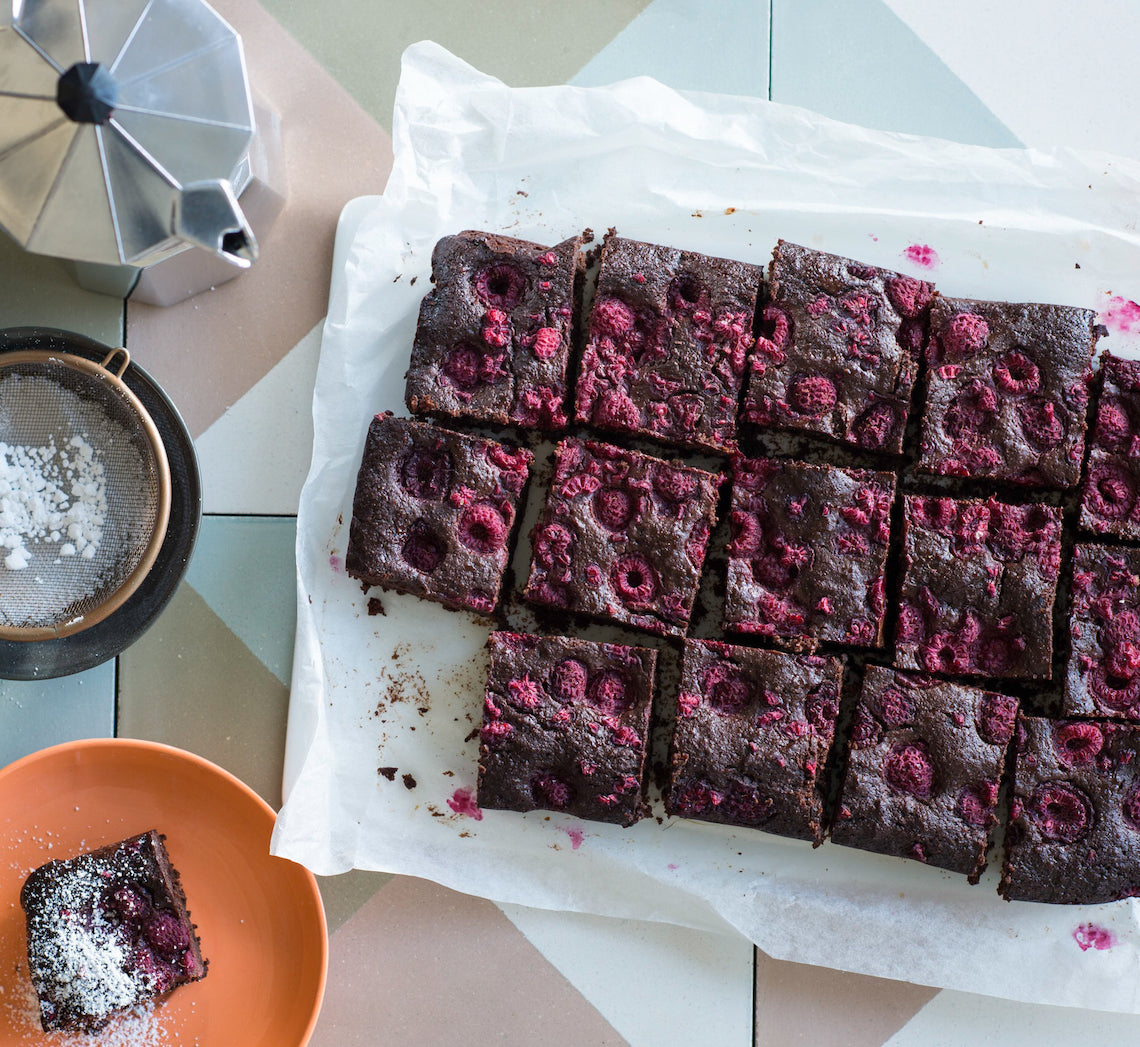
Prep 15minBake 35minMakes about 15
Wickedly rich, this gluten-free brownie can match it with the best of them. Fudgy, rich and studded with tart raspberries, you won't be able to stop at just one piece!
Ingredients
Coconut oil, to grease150g gluten-free, good-quality dark chocolate, chopped
100g (½ cup) coconut oil
135g (¾ cup) coconut sugar
2 eggs, at room temperature, light whisked
60ml (¼ cup) coconut milk
1 teaspoon natural vanilla essence or extract
30g (¼ cup) cocoa powder
2 tablespoons coconut flour
¾ teaspoon gluten-free baking powder
50g (½ cup) almond meal
150g frozen raspberries
Pure icing sugar, to dust (optional)
Method
- Preheat oven to 160°C (140°C fan-forced). Grease a 16cm x 26cm shallow slice tin with coconut oil and line the base and long sides with one piece of baking paper.
- Place the dark chocolate and coconut oil in a medium heatproof bowl over a saucepan of simmering water (don't let the base of the bowl touch the water). Stir occasionally until chocolate and coconut oil melt and the mixture is smooth. Remove bowl from the saucepan.
- Add the sugar, eggs, coconut milk and vanilla to chocolate mixture and use a balloon whisk to stir until well combined. Sift together the cocoa powder, coconut flour and baking powder into a bowl, add the almond meal and stir to combine. Add to chocolate mixture and stir with a spatula until just combined. Add the frozen raspberries and fold gently until just combined.
- Pour mixture into prepared tin and use the back of a metal spoon to spread evenly. Bake in preheated oven for 35 minutes or until moist crumbs cling to a skewer inserted in the centre. Cool in tin and then chill for at least 1 hour (see Baker's Tips).
- Remove brownie from the tin using the baking paper to carefully lift it out. Cut into portions and serve dusted with icing sugar, if desired.
Baker's Tips
- These brownies are a little more fragile than normal fudge brownies and will be easier to cut if you chill them for at least an hour before removing from the tin to cut.
- These brownies will keep in an airtight container in the fridge for up to 5 days. Serve straight from the fridge or stand at room temperature for 30 minutes before serving.
This recipe was originally published in Anneka's SBS Food online column, Bakeproof: Coconut.
Click here for more Bakeproof recipes.
Photography by Alan Benson.
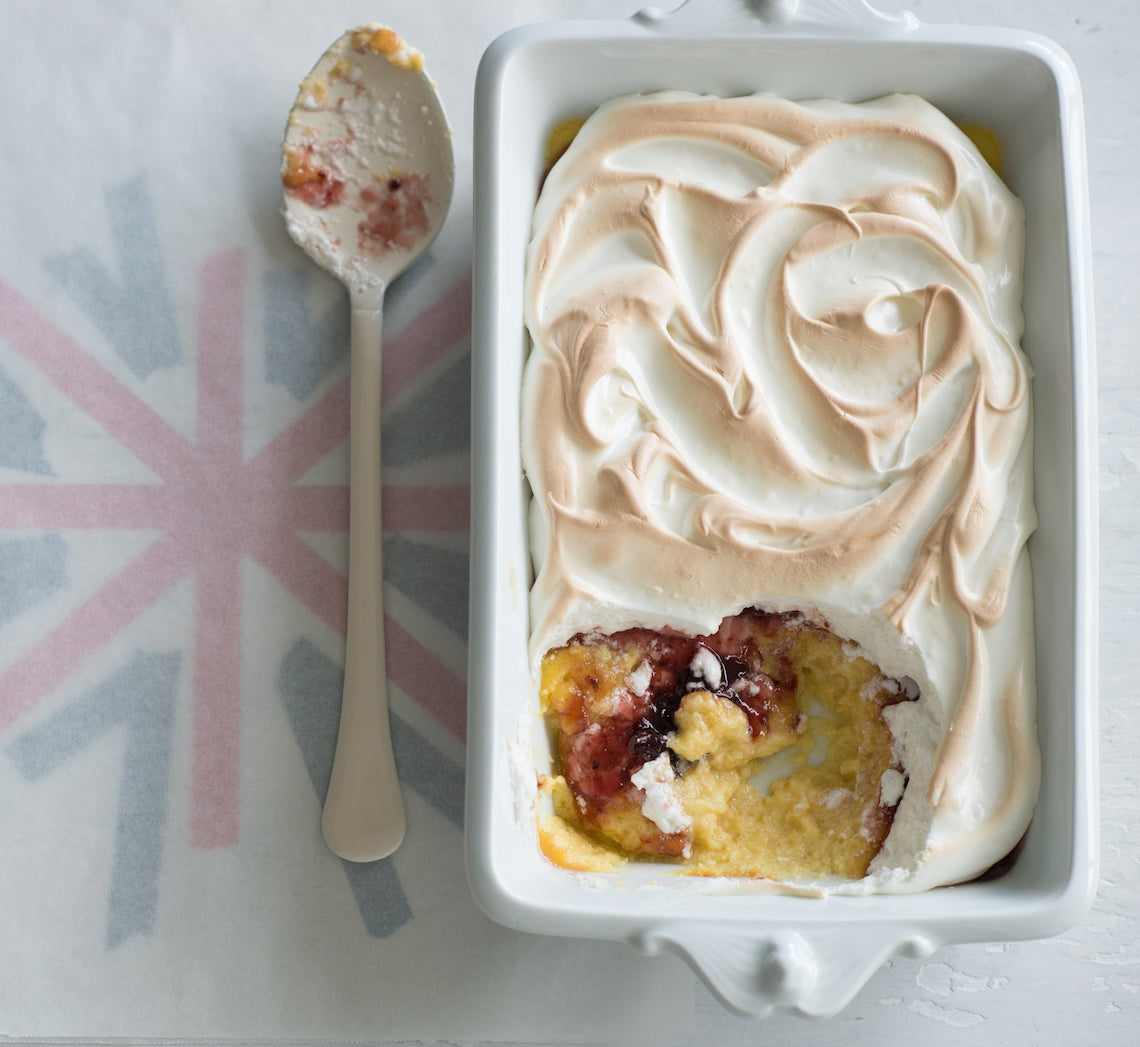
Prep 25minBake 30-35minMakes 8-10 serves
This traditional English pudding is quintessential nursery food – nurturing, soul-warming and economical. Feel free to replace the mixed berry jam with raspberry, plum or strawberry to ensure the sweet but subtle middle layer suits your tastes.
Ingredients
500ml (2 cups/17fl oz) milk
55g (¼ cup/2oz) caster sugar
30g (1 oz) salted butter, diced
Finely grated zest of 1 lemon
5 egg yolks (from 60g/2oz eggs), at room temperature
2½ teaspoons natural vanilla essence or extract
150g (2½ cups, lightly packed/5¼oz) fresh white breadcrumbs
85g (¼ cup/3oz) mixed berry jam (see Baker’s Tips)
1 tablespoon icing sugar, to dust
Meringue Topping
3 egg whites (form 60g/2oz eggs)
Large pinch of salt
110g (½ cup/4oz) caster sugar
1 teaspoon natural vanilla extract or essence
Method
- Put the milk, sugar, butter and lemon zest in a medium saucepan and stir over medium heat until the sugar dissolves and the butter melts. Use a balloon whisk to whisk the egg yolks in a medium heatproof bowl until smooth. Gradually add the warm milk mixture, whisking constantly until well combined. Stir in the vanilla and breadcrumbs.
- Pour the custard mixture into a shallow 1-litre (4-cup/1.75pt) ovenproof dish. Set aside for 15 minutes for the bread to soak up some of the custard.
- Preheat oven to 170ºC/340°F (150ºC/300°F fan-forced).
- Place the ovenproof dish into a roasting pan or larger ovenproof dish. Add enough boiling water to the roasting pan or larger ovenproof dish to reach halfway up the sides of the dish with the custard mixture to create a water bath or bain-marie.
- Bake in preheated oven for 20-25 minutes or until the custard has almost set but still wobbles slightly when touched on the top. Remove from the oven and remove the custard dish to a wire rack. Set aside for 20 minutes or until cooled slightly (stop here if pre-preparing your pudding, see Baker's Tips).
Increase the oven temperature to 190ºC/375°F (170ºC/340°F fan-forced).
- To make the Meringue Topping, use an electric mixer with a whisk attachment to whisk the egg whites and salt on medium-high speed until soft peaks form. With the motor running, gradually add the sugar, a spoonful at a time, and whisk until the sugar has dissolved completely and the mixture is thick and glossy. Whisk in the vanilla.
- Carefully spread the jam over the top of the custard (see Baker's Tips). Spread the Meringue Topping over the jam to cover, swirling as desired.
- Bake in preheated oven for 10 minutes or until the meringue is lightly golden (see Baker’s Tips). Serve immediately.
Baker's Tips
- You can cover the bottom of the roasting pan or larger ovenproof dish with a folded tea towel to stop the dish with the custard sliding around when transferring it to and from the oven.
- You can make this pudding up to the end of step 4 (note in method) up to 2 days before serving. Stand the puddings at room temperature for 30 minutes before continuing with the recipe.
- If your jam is a little thick you can warm it in a small saucepan over a low heat, stirring often, until runny, to make it easier to spread.
- You can caramelise the meringue topping with a blowtorch instead of baking it a second time for a more ‘dramatic’ effect if you wish.
This recipe is from Anneka's SBS Food online column, Bakeproof: Best of British Baking.
CLICK HERE for more Bakeproof recipes.
Photography by Alan Benson.






